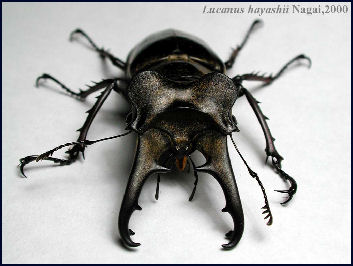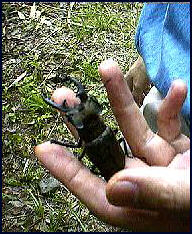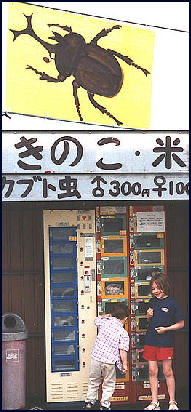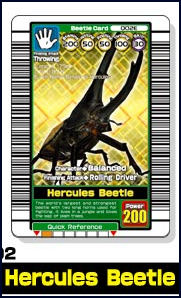BEETLES AND JAPAN

Japanese stag beetle Japanese are fond of buying and collecting beetles and keeping them as pets. They are particularly fond of stag beatles, fearsome- looking black insects with large jaw-like mandibles, and rhinoceros beetles, similar to stag beetles except the have a large "horn" protruding from their thorax above their head.
Stag beetles possess mandibles that are nearly as long as the beetle's body and resemble the antlers of a stag. Varying in lengths from 0.6 centimeters to 8.5 centimeters, they are smooth, black or reddish brown. Males are larger than females and have enlarged mandibles that are used in fights over females. There are about 1,000 species of stag and rhinoceros beetles in the world, with 20 species in Japan. Generally found in the forests and mountains around rotted logs and oak trees, the Japanese species are between 5 centimeters and 8 centimeters in length and hibernate in the winter.
In the wild, stag beetles are active mostly at night. Despite their large size they, like all beetles, can fly. Eggs are laid in decaying tree stumps or roots. Larvae live in rotten logs or are buried in the soil, feeding on rotten wood. Once they are large enough they pupate. Adults either do not feed on drink fluids such as nectar or sap, which they can smell.
In November 2007, new species of stag beetle — the takaneruri kuwagata beetle or “Platycerus sue Imura” — was discovered in Japan. Males have a turquoise metallic luster; females are bronze colored. Almost immediately after its discovery catching the beetle was banned and the place where it was found was kept secret after a pair of the insects was put for auction in the Internet for $1,000.
RELATED ARTICLES:
MUSHIS (INSECTS) IN JAPAN: MUCH-LOVED CICADAS, DRAGONFLIES, FIREFLIES factsanddetails.com
SCARY ARTHROPODS IN JAPAN: GIANT, VENOMOUS HORNETS, CENTIPEDES AND SPIDERS factsanddetails.com
Rhinoceros Beetles (Stag Beetles)
Kevin Short wrote in the Daily Yomiuri, “Male rhinoceros beetles have huge horns and solid, heavily-armored tanklike bodies and are immensely popular among elementary school boys. Called kabuto-mushi for their resemblance to the kabuto horned helmets worn by medieval samurai, they use their brushy mouthparts to mop up the sap that issues from the trunks of oak trees, and are thus very common in coppice woodlands. The larvae develop underground, in soft, humid substrate such as found in rotting logs or fermenting compost. [Source: Kevin Short, Daily Yomiuri, July 8, 2010]
“Male rhinoceros beetles are highly territorial. They stake out a good feeding spot and wait for females to arrive. All other males they challenge as opponents and competitors. A fight consists of two males trying to bulldoze each other off of the tree trunk. If one combatant gets his long front horn underneath his opponent, he uses it to flip him off into space. Boys manage their pet beetles like sumo champions, pampering them and bringing them to fight in mock tournaments.”
“Longhorn beetles are another interesting beetle species found in Japan. They “take their generic English name from their extra-long, whiplike antennae. In Japanese they are called kamikiri-mushi or "hair-cutter insects," based on their strong, sharp-edged jaws, which are said to be able to cut hair just like a pair of scissors.”
“Like the rhinoceros beetles, the longhorns feed primarily on tree sap. They use those powerful jaws to chew into the bark, causing the sap to flow, then lap it up. The females, however, deposit their eggs not in soft substrate, but directly into the tree trunk. The larva chew their way through the trunk, digesting the wood as they grow. Longhorn beetle larvae do not usually damage the trees directly, but they can wreak havoc by spreading fungal and bacteria diseases from one trunk to the next.”
The Batocera lineolata — called either white-striped longhorn beetle or chirping longhorn beetle in English and “ shirosuji kamikiri “ in Japanese, which means white-striped paper-cutter — is pale pastel yellow in color and nearly 5 centimeters long. It has powerful legs and thick, segmented antennae that are longer than the body. When picked up, the insect make a constant ghih-ghih chirping sound. The chirps are made by rapidly rubbing two serrated sections of the thorax together.
Beetles as Pets in Japan

Stag beetles make good pets. They take up little space in small Japanese dwelling, require little care and can be left alone for long periods of time. Some live to be five years old, which is longer than most hamsters.
Stag beetles are usually kept in plastic boxes. Some wood is usually placed in their box to make them feel at home. Instead of sap, the beetles are usually given pieces of cucumber or watermelon with a ball of cotton wool soaked in sugar. Pet shops sell a special jello used to feed them.
Pet shops say their most enthusiastic customers are men in their 30s and 40s. One adult beetle collected told Reuters, "I liked insects, even as a child. The shape, the black color, how it shines and the smart appearance of the beetles is what I like best.”
Another collected said "When I raise it and hold it in my hand I feel affection for it...They had different personalities — this one shy, that one is more aggressive, and so on." Schools sponsor beetle-hunting field trips for their students.
Buying Beetles in Japan

Beetle vending machine Stag beetles can be purchased at pet stores, department stores and shops that specialize in beetles. Enthusiasts can buy beetles from vending machines for ¥400. Credit card holders can order them through the Internet. The beetles are usually sold in pairs.
Millions of dollars worth of beetles accessories are sold every year. The are groups tours to the Philippines, Taiwan and Indonesia whose sole purpose is to collect stage beetles.
Most pet shop beetles sell for the equivalent of four or five dollars. High-priced ones go of as much as $2,500. Generally the bigger, the more valuable. Nepalese Dorcus antaeus, a type of stag beetle prized for its size, was selling for around $3,000 in the summer of 2001. Monster over 10 centimeters sold for $8,000 or more.
A massive Japanese stage beetle said to be a "black diamond" with "one in hundred of million" size was sold for $89,000 to a 36-year-old company president from a Tokyo insect specialty shop called Waku Waku Land. It was considered so valuable because of its size (9 centimeters).
The market for beetles is highly volatile. Big one that are worth thousands can be become worth hundreds in a matter of months depending on supply and demand and trendiness. The price of Japanese stage beetles collapsed after it was discovered how to breed them.
Beetle Fights in Japan

Mushi King, a beetle
fighting arcade game Beetle fights are held in small rings with the objective being for one beetle to turn its rival over or drive him out of the ring.
Describing a stag beetle fight, Masaki Iijimi of Reuters wrote, "Two giant black beetles lunge at each other on top of a log as dozens of children and adults watch eagerly. The long curved mandibles of the fighting stag beetles make clacking sounds on contact...The crowds gasps as a beetles lifts up its seven-centimeter opponent with its jaws and flings it off the log."
In the wild stag beetle males fight each for prized sap wounds. Sap wounds are also where males hang out in hopes of attracting a female. Males fight over the right to mate. To prepare their beetles for fights some collectors forced them to pull weight or have them fight smaller opponents to build up their confidence.
Mushi King, See Games
Mushi King

Mushi King arcade game The biggest video game craze in the mid 2000s was “Mushi King: the King of the Beetles” — a game that involved separately buying cards with images of large beetles’such as the Giraffe stag-beetle, the saw-tooth stag beetle or the Thailand five-horned beetle — on them and various information and feeding them into an arcade machine that show 3-D images of the beetles battling to the death.
Mushi King (“Bug King”) was introduced in 2003 by Sega who made money both from the selling of the cards and from the machines that played the cards. The game and cards were especially popular with preteen boys who fed cards into machines at toy stores and arcades. As of March 2007, 420 million cards and half million copies of the software that allowed the game to be played at home on Game Boy or PlayStations had been sold. At its peak more than 13,000 Mushi King arcade machines were in 5,200 locations.
There are 856 Mushi King cards, each one with a real beetle species. They sell for ¥100 a piece and are available only from the arcade machines. Each card carries a number that measures the beetle’s strength and stamina, which can be enhances with supplemental special “skill” cards. The beetles use moves like those found in profession wrestling. Each has a special Finishing Attack such as a Running Cutter, Tornado throw or Rolling Smash which it use to finish off an opponent.
Cardholders can battle other cardholders or beetles on the machine. The battles begin after the machine scans the bar codes on the cards. Players chose when and how to attack and the outcome is based as much on their skill and the values on their cards.
Mushi King is a make-believe version of an insect fight staged in a small ring such as those held between crickets in China. There is a television animation series that goes along with the game as well as merchandise such as lunchboxes and gloves.
Sources of Beetles in Japan

Most of the stag beetles sold in Japan are Japanese varieties. More and more large beetles from the jungles of Indonesia, Malaysia Cambodia, Nepal and India and being brought in the country. Some of these have exotic colors such as gold and iridescent blue-green. Finding beetles for the Japanese beetle collecting market is quite lucrative. More than 500 different species stag beetles, a third of the world’s known species, have been imported to Japan from Sabah and Sarawak in Borneo and Peninsular Malaysia.
Originally foreign beetles were not allowed in the country due to fears they might multiple and destroy crops. That changed on November 1999 when the government approved 31 kinds of foreign stag beetles for import. By January 2001, a total of 74 species had been approved.
In Japan, wild stag beetles are collected from oak trees that have been cut so that sap oozes out. The beetles as well many other kinds of insects are attracted to the sap. There are tour to the Philippines and Indonesia to collect beetles and other bugs there.
These days most of the beetles sold commercially are bred in farms. A typical farm produces 4,000 or so beetles and requires relatively little investment. The beetles are basically fed and left alone. In August adults lay eggs and wild beetles are introduced to prevent too much inbreeding. Desired traits such as large size and color are singled out and breed. Many collectors breed them at home and say that is the most interesting aspect of their hobby.
Beetle and Insect Poaching and Smuggling in Japan

Malaysian stag beetle Some of the species that have been approved in Japan are protected species in the countries they originate from. This has led to lucrative market for beetle poaching and smuggling, which is less risky than smuggling other animals because they are much smaller than other protected species and can easily be hidden in luggage. Particularly prized are the giant stag beetles found only in northen India, Nepal, Bhutan and Taiwan.
In August 2001, two Japanese men were arrested at Nepal's international airport for attempting to smuggle 271 pairs of indigenous stag beetles out of the country. Earlier a Japanese man was arrested in the Daman forests of Nepal for collecting insects without a permit. He was found with 49 varieties of insects. Violations involving stag beetles have also been reported in Brazil, India, and Taiwan.
Steeling beetles from shops also occurred. One shop in Tokyo had 80 beetles worth $70,000 stolen. It was not clear weather the thief was a professional thief after money or a fanatic collector after the prized beetles.
In December 2003, two Japanese men were arrested at Sydney airport, trying to smuggle out rare beetles and butterflies from Lord Howe Island. The men faced punishment of 10 years in prison and fines of up to $500,000. Authorities were expected to be harsh with them to set an example. The insects were airlifted back to Lord Howe Island.
Japanese beetles are face extinction as they are cross bred with non-native stag beetle specie.s from Southeast Asia that have been introduced as pets. They are also threatened by hunting for pets.
In July 2009, a Japanese man was arrested for illegally importing the world’s largest butterfly — the Queen Alexandra’s Birdwing, a native of Papua new Guinea — and selling it to a customer for $8,000. The man purchased the butterfly in Italy and had it sent to Japan from France.
Image Sources: 1) 2) Ray Kinnane 3) British Museum 4) Library of Congress, 5) 8) Japan-Animals blog 6) Tosa website 8) 9) 13) 14) Japanese stage beetlers Asahi net 10) Doug Mann Photmann, 11) 12) Mushi King official site,Wikimedia Commons
Text Sources: Animal Diversity Web animaldiversity.org ; National Geographic, Live Science, Natural History magazine, David Attenborough books, Daily Yomiuri, Yomiuri Shimbun, Japan National Tourist Organization (JNTO), New York Times, Washington Post, Los Angeles Times, Smithsonian magazine, Discover magazine, The New Yorker, Time, BBC, CNN, Reuters, Associated Press, AFP, Lonely Planet Guides, Wikipedia, The Guardian, Top Secret Animal Attack Files website and various books and other publications.
Last updated March 2025
